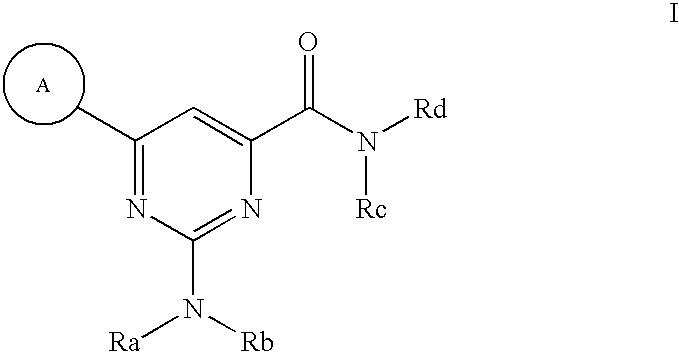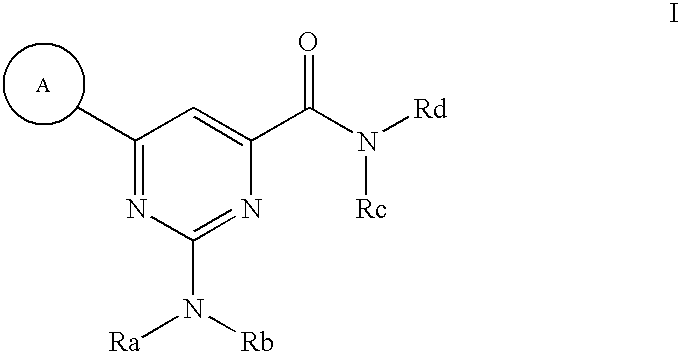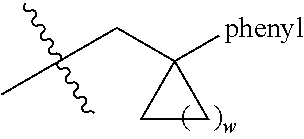Modulators of ATP-binding cassette transporters
a cassette and module technology, applied in the field of modulers of atp-binding cassette (“ abc”) transporters, can solve the problems of imbalance in ion and fluid transport, debilitating and fatal effects of cf, and reducing anion transport, so as to reduce the severity
- Summary
- Abstract
- Description
- Claims
- Application Information
AI Technical Summary
Benefits of technology
Problems solved by technology
Method used
Image
Examples
example 1
2-(dimethylamino)-6-(2-methoxyphenyl)pyrimidine-4-carboxamide
Step a: 4-(2-methoxyphenyl)-2,4-dioxobutanoic acid
[0197]
[0198]To a stirred solution of diethyl oxalate (16 g, 110 mmol) and sodium ethoxide (100 mL, 21% by wt. in ethanol, 300 mmol) was added dropwise a solution of 2-methoxy acetophenone (15 g, 100 mmol) in ethanol (100 mL). The reaction mixture was allowed to stir at ambient temperature overnight. The resulting solution was concentrated to approximately 50 mL on a rotary evaporator, followed by partitioning between diethyl ether (100 mL) and water (250 mL). The aqueous layer was adjusted to pH=3 with conc. HCl to give a suspension with a fine white precipitate, which was heated at 100° C. for 5-10 minutes followed by cooling in an ice bath for 1 h. The precipitate was filtered, washed with water (20 mL), and dried overnight under high vacuum to give 4-(2-methoxyphenyl)-2,4-dioxobutanoic acid. 1H NMR (300 MHz, CDCl3) δ 7.96 (q, J=9.0, 3.0 Hz, 1H), 7.53 (t, J=6.0 Hz, 1H), 7...
example 2
2-(N-methylphenethylamino)-6-phenylpyrimidine-4-carboxamide
Step a: 2,4-dioxo-4-phenylbutanoic acid
[0208]
[0209]To a stirred solution of diethyl oxalate (21.9 g, 150 mmol) and sodium ethoxide (168 mL, 21% wt. solution, 450 mmol) was added dropwise a solution of acetophenone (18 g, 150 mmol) in ethanol (120 mL). The reaction mixture was allowed to stir at ambient temperature for 15 h. The reaction mixture was concentrated to ca. 70 mL and partitioned between diethyl ether (50 mL) and water (200 mL). The phases were separated, and the aqueous layer adjusted to pH=1 with conc. HCl before being extracted with diethyl ether (3×100 mL). The combined ether extracts were dried over MgSO4 and evaporated to yield 2,4-dioxo-4-phenylbutanoic acid. 1H NMR (DMSO-d6, 300 MHz) δ 8.05 (d, J=7.2 Hz, 1.8H enol form), 7.96 (d, J=6.9 Hz, 0.2H keto form), 7.69 (t, J=7.5 Hz, 1H), 7.56 (t, J=8.1 Hz, 2H), 7.08 (s, 0.9H enol form), 4.56 (s, 0.1H keto form). 13C NMR (DMSO-d6, 75 MHz) δ 190.7, 170.7, 163.6, 135....
example 3
2-diethylamino-6-(2,6-dimethoxy-phenyl)-pyrimidine-4-carboxylic acid amide
Step a: 2-methylsulfanyl-6-oxo-1,6-dihydro-pyrimidine-4-carboxylic acid
[0219]
[0220]Neat diethyl oxalacetate (23.5 g, 125 mmol) was added to a solution of sodium hydroxide (15 g, 0.375 mol, 3 eq) in water (150 mL), giving a yellow solution. Solid S-methylisothiourea sulfate (17.4 g, 62.5 mmol, 0.5 eq) was added to the stirred solution. The mixture was stirred 15 hours. Concentrated HCl (40 mL, 0.48 mol) was added bringing the pH to 1, the resultant pale orange-pink suspension was stirred vigorously for 2 hours then filtered. The filter cake was washed with water (100 mL), and dried under high vacuum to afford 2-methylsulfanyl-6-oxo-1,6-dihydro-pyrimidine-4-carboxylic acid as an off-white solid. 1H NMR (500 MHz, DMSO-d6) □ 13.22 (br s, 1H), 6.60 (s, 1H), 3.37 (br s, 1H), 2.53 (s, 3H); ESI-MS m / z 186.9 (M+H)+.
Step b: 6-chloro-2-methylsulfanyl-pyrimidine-4-carboxylic acid methyl ester
[0221]
[0222]A 250 mL flask was...
PUM
| Property | Measurement | Unit |
|---|---|---|
| temperature | aaaaa | aaaaa |
| temperature | aaaaa | aaaaa |
| temperature | aaaaa | aaaaa |
Abstract
Description
Claims
Application Information
 Login to View More
Login to View More - R&D
- Intellectual Property
- Life Sciences
- Materials
- Tech Scout
- Unparalleled Data Quality
- Higher Quality Content
- 60% Fewer Hallucinations
Browse by: Latest US Patents, China's latest patents, Technical Efficacy Thesaurus, Application Domain, Technology Topic, Popular Technical Reports.
© 2025 PatSnap. All rights reserved.Legal|Privacy policy|Modern Slavery Act Transparency Statement|Sitemap|About US| Contact US: help@patsnap.com



